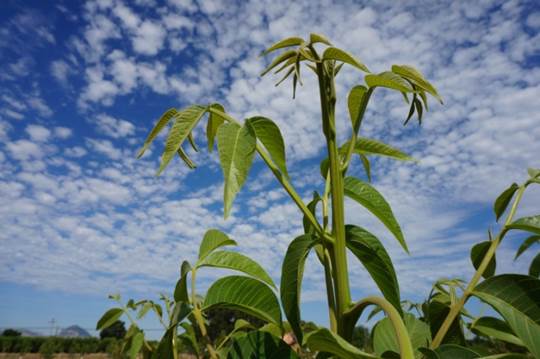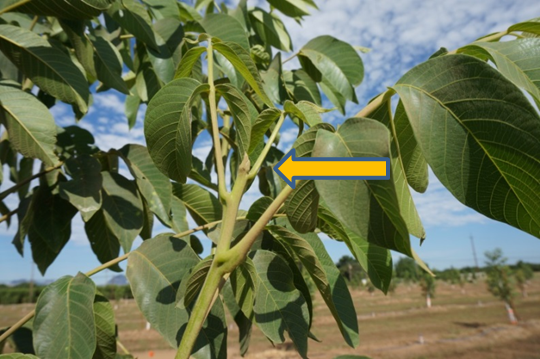California’s hot, sometimes smoky September weather generally doesn’t trigger concerns about frost damage in young walnuts, but retired UCCE tree crop farm advisor Janine Hasey said September is the month growers should prepare for freezing temperatures. Newly planted trees and first and second leaf trees are especially vulnerable to freezing temperatures in the fall and winter.
“You want to harden them off to prevent damage,” Hasey said.
That means stopping vigorous new growth. Finishing nitrogen fertilizer applications in first and second leaf trees by the end of August is a good start. The next consideration is to begin cutting back on irrigation. Not all at once, Hasey said, but cutting back irrigation beginning mid-September until a terminal bud is set on the trunk of young trees will help the trees transition to colder weather.
Once the bud has set, usually by mid- to late-October, and if rainfall has not occurred, Hasey said it is important to irrigate so there is soil moisture in the top foot of the profile by early November. If rainfall is insufficient, this late fall irrigation is critical in frost damage prevention. Dry soils should receive irrigation three to five days before a freeze event is forecast. Wetting the soil will fill air spaces enabling the soil to store heat. Standing water in the orchard should be avoided since it will make the soil surface colder due to evaporative cooling.
Hasey noted that the late irrigation might be a problem for growers who use surface water because some irrigation districts have curtailed deliveries for the year. For those orchards, growers may want to consider irrigating before the cut-off date if rainfall is insufficient. Once the terminal bud is set, regrowth is unlikely from rainfall or an irrigation.
Fully dormant walnut trees are more tolerant of frost and can take temperatures to the low 20s F if they have been acclimated. If the first freeze event of the season is severe, damage is more likely to occur.
If a freeze event occurs, growers should check the trees for damage by cutting into the tissue. If tissue is green, tress have escaped damage, but if brown discoloration is seen, growers should consider painting the trunks with a 50% diluted white latex paint, focusing on the southwest facing trunk surface, as soon as possible.
Unhardened and vigorous young walnut trees are especially vulnerable to sudden autumn freeze events, but damage to mature walnut trees is not unheard of. Hasey said there was a severe freeze event in November 2018 that also caused severe damage in older orchards throughout the Sacramento and northern San Joaquin Valleys. This emphasizes that both younger and older orchards should have moisture in the soil going into early November.













